Historic RARE 1972 African American BLACK ARTS Abstract Lithograph, SAMELLA
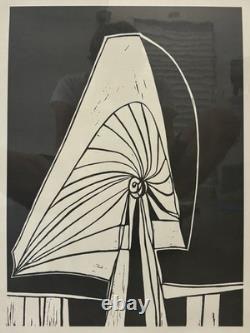
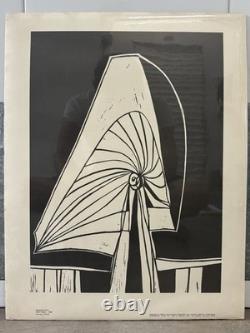
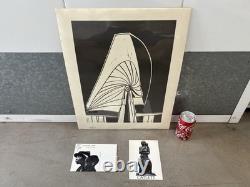
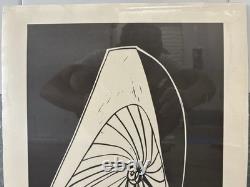
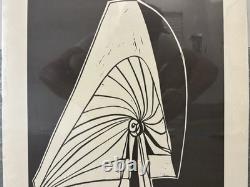
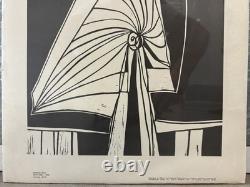
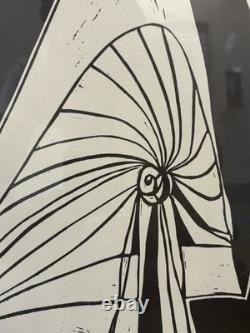
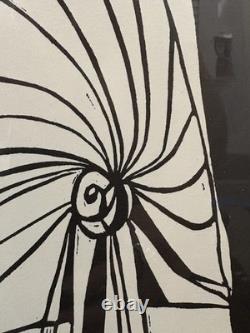
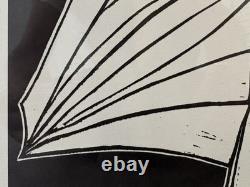
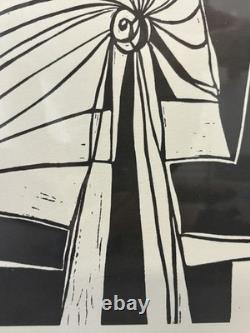
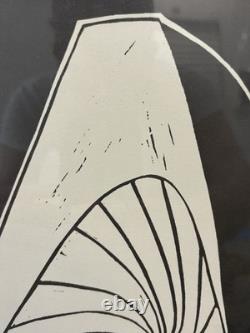
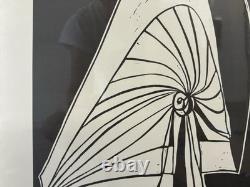
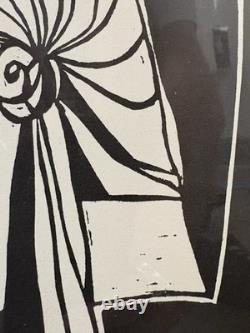
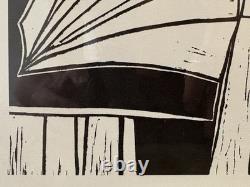

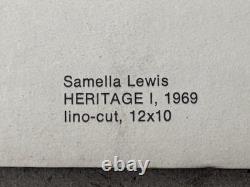
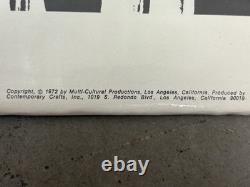
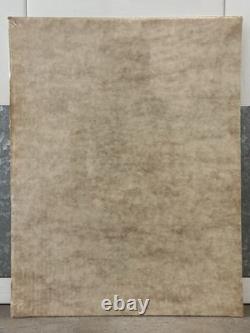

This is an expressive and thought provoking Historic RARE 1972 African American BLACK ARTS Abstract Lithograph on Paper, by the esteemed early African American female Modernist painter, sculptor and printmaker, Samella Lewis 1923 - 2022. This fascinating artwork displays abstracted swirls, bold line work, and sharp angles, reminiscent of Joan Miro.
In the center of the image, you can possibly make out the profile of an enigmatic figure. At the lower left edge of the sheet, it reads: Samella Lewis. Produced for Contemporary Crafts, Inc. This groundbreaking publishing house was founded by Samella Lewis and fellow artist, Bernie Casey (1939 - 2017) between 1969 and 1971. This lithograph is approximately 14 x 18 inches. Very good condition for decades of age and storage, with some light scuffing and edge wear. It is still wrapped in plastic! This item was acquired from the contents of the long - defunct Gallery/Tanner in Los Angeles, California, which was founded by African American fine artist and luminary, Samella Lewis. I acquired the entire remaining contents of this closed down and important early Los Angeles African American art gallery, and will be listing many more important, historic, and incredibly rare 1960's - 1970's Black Arts Movement artwork and ephemera in the days and weeks to come. You cannot find this rare print anywhere. If you like what you see, I encourage you to make an Offer. Please check out my other listings for more wonderful and unique artworks! 1924 - New Orleans, Louisiana. Printmaking, modernist figure and genre painting, art historian.Samella Sanders Lewis (1924 - 2022) was active/lived in California, Louisiana. Samella Lewis is known for Printmaking, modernist figure and genre painting, art historian. Artist and art historian Samella Lewis is renowned for her contributions to African American art and art history. Born on February 27, 1924, in New Orleans, Louisiana, Lewis's heritage led her to view art as an essential expression of the community and its struggles. Lewis began her art career as a student at Dillard University, where she was instructed by the African American sculptor Elizabeth Catlett.
At one of her instructor's suggestions, Lewis transferred to Hampton Institute, where she earned her B. Degree in art history in 1945. Lewis completed her graduate studies at the Ohio State University, earning her M.Degree in 1948, and in 1951 she became the first African American woman to receive her doctorate in fine arts and art history. In order to publish Black Artists on Art (1969), Lewis founded the first African American-owned art publishing house, Contemporary Crafts.
From 1969 to 1984, Lewis worked as professor of art history at Scripps College in Claremont, California, becoming the college's first tenured African American professor. Lewis also helped to found the Museum of African American Art in Los Angeles in 1976 and established the scholarly journal International Review of African American Art that same year. The journal went on to become one of the leading forum for educating scholars and others about the many contributions African Americans have made to the visual arts.Lewis published African American Art and Artists in 1978, a history of African American art since the colonial era. Through the museum and journal she founded, Lewis created exhibition opportunities for African American artists which have bolstered their credibility.
Lewis's work was exhibited in many important galleries and museums. Lewis's deeply-personal art embodies some experience from her own life in each piece. Lewis received several awards and distinctions; in 1995, she received the UNICEF Award for the Visual Arts, and from 1996 to 1997 worked as a distinguished scholar at the Getty Center for the History of Art and the Humanities in Los Angeles.
Scripps College has also named an academic scholarship in Lewis's honor. Lewis and her husband, Paul G. Lewis, were married in 1948; the couple raised two children. Source: "Samella Lewis", The History Makers. Biography from The Johnson Collection. While she works in a variety of media, Lewis is best known as a printmaker. Often utilizing the human figure, her oeuvre speaks to the struggle and strength of the African American community.Growing up in segregated New Orleans exposed Lewis to racial prejudice; art offered a powerful vehicle to express her response to human injustice. As a youth, she was influenced by comic books, an affinity borne out in her own graphic art. In 1941, she received a scholarship to attend nearby Dillard University.
Dillard professor Elizabeth Catlett (and lifelong friend) recognized Lewis' remarkable potential and advised her to transfer to the Hampton Institute in Virginia (now Hampton University). She graduated from Hampton-where John Biggers was among her classmates-in 1945. At the recommendation of her instructor Viktor Lowenfeld, she immediately joined the school's art faculty and taught for two years. Lowenfeld also encouraged her to attend graduate school, suggesting Ohio State University.
Lewis initially planned to pursue a printmaking degree but took so many courses in art history that her advisor suggested she major in "studio art history, " effectively combining both master's degrees. She received her PhD from Ohio State in 1951, becoming the first female African American to earn a doctorate in art history. While completing her dissertation, she taught at Morgan College (now Morgan State University) in Baltimore. By 1953, she had been named art department chair at Florida A&M University, where she organized the first professional conference for African American artists, the National Conference of Artists, that same year. As a graduate student, Lewis developed an interest in Asian art, which she continued to foster when she moved to the State University of New York in Plattsburgh in 1958.A Fulbright fellowship for study in Taiwan afforded her the chance to expand her research in the field, followed by postdoctoral classes at the University of Southern California and New York University. Although she liked Plattsburgh's progressive curriculum, Lewis relocated to Los Angeles, so her children could experience a more multicultural population. In 1968, Lewis became the education coordinator at the Los Angeles County Museum of Art, a position she hoped to use to increase exhibition opportunities for black artists. Repeated clashes with museum administrators over the hiring of more staff of African descent led Lewis to resign. She would go on to establish three independent art galleries and, in 1976, founded the Museum of African American Art in Los Angeles, where she served as senior curator until 1986.
When she and fellow artist-scholar Ruth Waddy sought to publish their landmark two-volume guide on African American artists, Black Artists on Art (1969 and 1971), Lewis co-founded Contemporary Crafts Gallery, the first African American-owned art publishing house. She also founded the noted academic journal, International Review of African American Art, in 1976. Her documentary interviews with prominent African American artists, such as Catlett and Richmond Barthé, were eventually published in the seminal text Art: African American (1978). During this same period, she made several short films celebrating the careers of African American artists. In recognition of her contribution to the arts and specifically to the field of African American art history, Samella Lewis received the UNICEF Award for the Visual Arts in 1995.
She was also a distinguished scholar at the Getty Center for the History of Art and the Humanities in Los Angeles from 1996 to 1997. Her work can be found at national art museums such as the Museum of Modern Art, the Metropolitan Museum of Art, and the Hampton University Museum. The Johnson Collection, Spartanburg, South Carolina.
Samella Sanders Lewis (February 27, 1923 - May 27, 2022) was an African - American visual artist and art historian. She worked primarily as a printmaker. She has been called the "Godmother of African American Art".She received Distinguished Artist Award for Lifetime Achievement from the College Art Association. Art is not a luxury as many people think - it is a necessity. It documents history - it helps educate people and stores knowledge for generations to come. Samella Sanders was born to Samuel Sanders and Rachel Taylor Sanders in New Orleans.
On February 27, 1923, and raised in Ponchatoula. Her father worked as a farmer and mother along other jobs worked as a domestic worker. Widely exhibited and collected as an artist herself, Lewis was better known as a historian, critic, and collector of art, especially African - American art. Lewis completed four degrees, five films, seven books, and a substantial body of artworks which have received critical respect.She pursued an art degree starting off at Dillard University. In 1941, but left Dillard for Hampton Institute. Earning her master's degree in 1947. Then completed her master and doctorate in art history and cultural anthropology at the Ohio State University.
Lewis was the first female African American to earn a doctorate in fine art and art history. While finishing her doctorate, Lewis taught art at Morgan State University.
Lewis became the first Chair of the Fine Arts Department at Florida A&M University. In 1953; that same year Lewis also became the first African American to convene the National conference of African - American artists held at Florida A&M University. She was a professor at the State University of New York. California State University, Long Beach.
She co-founded, with Bernie Casey, the Contemporary Crafts Gallery in Los Angeles in 1970. In 1973, she served on the selection committee for the exhibition BLACKS: USA: 1973 held at the New York Cultural Center. Lewis's grandson is Bay Area artist and musician Unity Lewis. I wanted to make a chronology of African American artists, and artists of African descent, to document our history.
The historians weren't doing it. I felt it better the artists do it anyway, through pictorial and written information. It was really about the movement, Samella Lewis said of the book published in 1969 and 1971. In 1960-70s, Samella Lewis belonged to a group of artists that would meet every month. Lewis began collecting art in 1942. She mostly collected art from WPA. In the 1960s and 1970s Lewis's work, which includes lithographs. Linocuts, and serigraphs, reflected humanity and freedom.Between 1969 and 1970, Lewis and E. Montgomery were consultants for a "groundbreaking" exhibition creating awareness to the history of African American history and art. Lewis was the founder of the International Review of African American Art in 1975. In 1976, she founded the Museum of African - American Art. With a group of artistic, academic, business and community leaders in Los Angeles, California.
These founders had similar goals, including increasing the public's awareness of African American art. Many individuals and corporations, such as Macy's. Made generous donations to the museum. Lewis, as the staff's senior curator in the museum, not only organized a great number of exhibitions but also developed diverse ways of educating the public on African American arts.
In an article, she discussed the ideas of "art of tradition", and argued that museums had the responsibility to explore the African roots of African American art. The museum operates on donations in the Baldwin Hills Crenshaw Plaza. With staff and volunteers who are dedicated to supporting the museum. Lewis once mentioned an "art of inspiration" based on the experiences of African Americans themselves.
Lewis founded three other museums in the Los Angeles, California. Member, and a collector of art with her collection including African, Chinese, Asian, South American, and other works. Some of the art that Lewis collected was transferred to the Hampton Institute, now the University Museum. In 1984, she produced a monograph on the artist Elizabeth Catlett. Who had been one of Lewis's mentors at Dillard University.In 2012, works by Lewis were exhibited alongside selected artworks from her personal collection in Samella Lewis and the African American Experience at Louis Stern Fine Arts. The exhibition was accompanied by a full-color catalogue with text by art writer and critic Suzanne Muchnic.
In 2015, Unity Lewis and art entrepreneur Trevor Parham created The Legacy Exhibit, which featured three generations of black fine artists, including contemporary artists as well as some included in the original Black Artists on Art. The show launched their recruitment efforts for 500 black American artists to participate in the updated volumes. Lewis married mathematician Paul Gad Lewis in 1948, and they had two sons.
She died from renal failure in a hospice in Torrance, California. On May 27, 2022, at the age of 99. 1969: Samella Lewis and George Clack, Brockman Gallery, Los Angeles. 1980: Solo Exhibition, University Union Gallery, California Polytechnic State University, Pomona, California. 1980: Smithsonian Institution traveling exhibition, United States and Canada. 1981: Solo exhibition, Pasadena City College, Pasadena, California. 1981: Solo exhibition, University of California, San Diego. 1984: African American Art in Atlanta, Public and Corporate Collections , High Museum of Art. 1984: Solo exhibition, Museum of African American Art, Los Angeles, California. 2012: Samella Lewis and the African American Experience , Louis Stern Fine Arts.1962: Fulbright Fellowship to study Asian culture at First Institute of Chinese Civilization and Tung Mai University, Taiwan. 1964-65: National Defense Education Act postdoctoral fellow at University of Southern California, studying Chinese language and Asian civilization. 1993: Charles White lifetime Achievement Award. Award for the Visual Arts. 1996-97: Named a Distinguished Scholar by the Getty Center for the History of Art and Humanities.
2003: The History Maker Award. 2004: Special Day Recognition Award for Outstanding Contributions from the City of New Orleans. 2005: Alumni Association Award from the Ohio State University.
2021: Distinguished Artist Award for Lifetime Achievement from the College Art Association.

